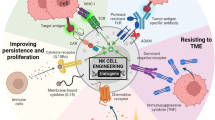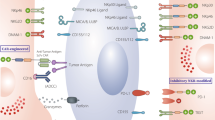Abstract
Natural killer (NK) cells hold promise for cancer therapy. NK cytotoxicity can be enhanced by expression of chimeric antigen receptors that re-direct specificity toward target cells by engaging cell surface molecules expressed on target cells. We developed a regulatory-compliant, scalable non-viral approach to engineer NK cells to be target-specific based on transfection of mRNA encoding chimeric receptors. Transfection of eGFP mRNA into ex vivo expanded NK cells (N=5) or purified unstimulated NK cells from peripheral blood (N=4) resulted in good cell viability with eGFP expression in 85±6% and 86±4%, 24 h after transfection, respectively. An mRNA encoding a receptor directed against CD19 (anti-CD19-BB-z) was also transfected into NK cells efficiently. Ex vivo expanded and purified unstimulated NK cells expressing anti-CD19-BB-z exhibited enhanced cytotoxicity against CD19+ target cells resulting in ⩾80% lysis of acute lymphoblastic leukemia and B-lineage chronic lymphocytic leukemia cells at effector target ratios lower than 10:1. The target-specific cytotoxicity for anti-CD19-BB-z mRNA-transfected NK cells was observed as early as 3 h after transfection and persisted for up to 3 days. The method described here should facilitate the clinical development of NK-based antigen-targeted immunotherapy for cancer.
This is a preview of subscription content, access via your institution
Access options
Subscribe to this journal
Receive 12 print issues and online access
$259.00 per year
only $21.58 per issue
Buy this article
- Purchase on Springer Link
- Instant access to full article PDF
Prices may be subject to local taxes which are calculated during checkout






Similar content being viewed by others
References
Schroers R, Hildebrandt Y, Hasenkamp J, Glass B, Lieber A, Wulf G et al. Gene transfer into human T lymphocytes and natural killer cells by Ad5/F35 chimeric adenoviral vectors. Exp Hematol 2004; 32: 536–546.
Ruggeri L, Capanni M, Urbani E, Perruccio K, Shlomchik WD, Tosti A et al. Effectiveness of donor natural killer cell alloreactivity in mismatched hematopoietic transplants. Science 2002; 295: 2097–2100.
Ruggeri L, Mancusi A, Burchielli E, Aversa F, Martelli MF, Velardi A . Natural killer cell alloreactivity in allogeneic hematopoietic transplantation. Curr Opin Oncol 2007; 19: 142–147.
McKenna Jr DH, Sumstad D, Bostrom N, Kadidlo DM, Fautsch S, McNearney S et al. Good manufacturing practices production of natural killer cells for immunotherapy: a six-year single-institution experience. Transfusion 2007; 47: 520–528.
Miller JS, Soignier Y, Panoskaltsis-Mortari A, McNearney SA, Yun GH, Fautsch SK et al. Successful adoptive transfer and in vivo expansion of human haploidentical NK cells in patients with cancer. Blood 2005; 105: 3051–3057.
Farag SS, Fehniger TA, Ruggeri L, Velardi A, Caligiuri MA . Natural killer cell receptors: new biology and insights into the graft-versus-leukemia effect. Blood 2002; 100: 1935–1947.
Chiorean EG, Miller JS . The biology of natural killer cells and implications for therapy of human disease. J Hematother Stem Cell Res 2001; 10: 451–463.
Lanier LL . Activating and inhibitory NK cell receptors. Adv Exp Med Biol 1998; 452: 13–18.
Passweg JR, Tichelli A, Meyer-Monard S, Heim D, Stern M, Kühne T et al. Purified donor NK-lymphocyte infusion to consolidate engraftment after haploidentical stem cell transplantation. Leukemia 2004; 18: 1835–1838.
Schellekens J, Rozemuller EH, Petersen EJ, van den Tweel JG, Verdonck LF, Tilanus MG . Activating KIRs exert a crucial role on relapse and overall survival after HLA-identical sibling transplantation. Mol Immunol 2008; 45: 2255–2261.
Klingemann HG . Natural killer cell-based immunotherapeutic strategies. Cytotherapy 2005; 7: 16–22.
Kolb HJ, Schattenberg A, Goldman JM, Hertenstein B, Jacobsen N, Arcese W et al. Graft-versus-leukemia effect of donor lymphocyte transfusions in marrow grafted patients. Blood 1995; 86: 2041–2050.
Verdonck LF, Petersen EJ, Lokhorst HM, Nieuwenhuis HK, Dekker AW, Tilanus MG et al. Donor leukocyte infusions for recurrent hematologic malignancies after allogeneic bone marrow transplantation: impact of infused and residual donor T cells. Bone Marrow Transplant 1998; 22: 1057–1063.
Collins Jr RH, Goldstein S, Giralt S, Levine J, Porter D, Drobyski W et al. Donor leukocyte infusions in acute lymphocytic leukemia. Bone Marrow Transplant 2000; 26: 511–516.
Gratwohl A, Brand R, Apperley J, Crawley C, Ruutu T, Corradini P et al. Allogeneic hematopoietic stem cell transplantation for chronic myeloid leukemia in Europe 2006: transplant activity, long-term data and current results. An analysis by the Chronic Leukemia Working Party of the European Group for Blood and Marrow Transplantation (EBMT). Haematologica 2006; 91: 513–521.
Abbott BL . Recent advances in chronic lymphocytic leukemia. Cancer Invest 2006; 24: 302–309.
Eshhar Z . The T-body approach: redirecting T cells with antibody specificity. Handb Exp Pharmacol 2008: 329–342.
Imai C, Iwamoto S, Campana D . Genetic modification of primary natural killer cells overcomes inhibitory signals and induces specific killing of leukemic cells. Blood 2005; 106: 376–383.
Imai C, Mihara K, Andreansky M, Nicholson IC, Pui CH, Geiger TL et al. Chimeric receptors with 4-1BB signaling capacity provoke potent cytotoxicity against acute lymphoblastic leukemia. Leukemia 2004; 18: 676–684.
Biagi E, Marin V, Giordano Attianese GM, Dander E, D'Amico G, Biondi A . Chimeric T-cell receptors: new challenges for targeted immunotherapy in hematologic malignancies. Haematologica 2007; 92: 381–388.
Cooper LJ, Ausubel L, Gutierrez M, Stephan S, Shakeley R, Olivares S et al. Manufacturing of gene-modified cytotoxic T lymphocytes for autologous cellular therapy for lymphoma. Cytotherapy 2006; 8: 105–117.
Finney HM, Akbar AN, Lawson AD . Activation of resting human primary T cells with chimeric receptors: costimulation from CD28, inducible costimulator, CD134, and CD137 in series with signals from the TCR zeta chain. J Immunol 2004; 172: 104–113.
Brentjens RJ, Santos E, Nikhamin Y, Yeh R, Matsushita M, La Perle K et al. Genetically targeted T cells eradicate systemic acute lymphoblastic leukemia xenografts. Clin Cancer Res 2007; 13: 5426–5435.
Kowolik CM, Topp MS, Gonzalez S, Pfeiffer T, Olivares S, Gonzalez N et al. CD28 costimulation provided through a CD19-specific chimeric antigen receptor enhances in vivo persistence and antitumor efficacy of adoptively transferred T cells. Cancer Res 2006; 66: 10995–11004.
Brentjens RJ . Novel approaches to immunotherapy for B-cell malignancies. Curr Hematol Rep 2005; 4: 64–72.
Loskog A, Giandomenico V, Rossig C, Pule M, Dotti G, Brenner MK . Addition of the CD28 signaling domain to chimeric T-cell receptors enhances chimeric T-cell resistance to T regulatory cells. Leukemia 2006; 20: 1819–1828.
Zimmermann U . Electrical breakdown, electropermeabilization and electrofusion. Rev Physiol Biochem Pharmacol 1986; 105: 176–256.
Golzio M, Rols MP, Teissie J . In vitro and in vivo electric field-mediated permeabilization, gene transfer, and expression. Methods 2004; 33: 126–135.
Hui S, Li L . In vitro and ex vivo delivery of genes to cells by electroporation. Electrically Mediated Delivery of Molecules to Cells: Electrochemotherapy, Electrogene Therapy and Transdermal Delivery by Electroporation. In: Jaroszeski MJ, Gilbert R, Heller R (eds) Human Press: New Jersey, 2000 pp 157–172.
Xie TD, Sun L, Tsong TY . Study of mechanisms of electric field-induced DNA transfection. I. DNA entry by surface binding and diffusion through membrane pores. Biophys J 1990; 58: 13–19.
Li LH, Shivakumar R, Feller S, Allen C, Weiss JM, Dzekunov S et al. Highly efficient, large volume flow electroporation. Technol Cancer Res Treat 2002; 1: 341–350.
Manabe A, Coustan-Smith E, Kumagai M, Behm FG, Raimondi SC, Pui CH et al. Interleukin-4 induces programmed cell death (apoptosis) in cases of high-risk acute lymphoblastic leukemia. Blood 1994; 83: 1731–1737.
Li LH, Sen A, Murphy SP, Jahreis GP, Fuji H, Hui SW . Apoptosis induced by DNA uptake limits transfection efficiency. Exp Cell Res 1999; 253: 541–550.
Li LH, McCarthy P, Hui SW . High-efficiency electrotransfection of human primary hematopoietic stem cells. FASEB J 2001; 15: 586–588.
Bell MP, Huntoon CJ, Graham D, McKean DJ . The analysis of costimulatory receptor signaling cascades in normal T lymphocytes using in vitro gene transfer and reporter gene analysis. Nat Med 2001; 7: 1155–1158.
Van Tendeloo VF, Willems R, Ponsaerts P, Lenjou M, Nijs G, Vanhove M et al. High-level transgene expression in primary human T lymphocytes and adult bone marrow CD34+ cells via electroporation-mediated gene delivery. Gene Ther 2000; 7: 1431–1437.
Lai W, Chang CH, Farber DL . Gene transfection and expression in resting and activated murine CD4T cell subsets. J Immunol Methods 2003; 282: 93–102.
Trompeter HI, Weinhold S, Thiel C, Wernet P, Uhrberg M . Rapid and highly efficient gene transfer into natural killer cells by nucleofection. J Immunol Methods 2003; 274: 245–256.
Maasho K, Marusina A, Reynolds NM, Coligan JE, Borrego F . Efficient gene transfer into the human natural killer cell line, NKL, using the Amaxa nucleofection system. J Immunol Methods 2004; 284: 133–140.
Li LH, Biagi E, Allen C, Shivakumar R, Weiss JM, Feller S et al. Rapid and efficient nonviral gene delivery of CD154 to primary chronic lymphocytic leukemia cells. Cancer Gene Ther 2006; 13: 215–224.
Landi A, Babiuk LA, van Drunen Littel-van den Hurk S . High transfection efficiency, gene expression, and viability of monocyte-derived human dendritic cells after nonviral gene transfer. J Leukoc Biol 82: 849–860.
Van De Parre TJ, Martinet W, Schrijvers DM, Herman AG, De Meyer GR . mRNA but not plasmid DNA is efficiently transfected in murine J774A.1 macrophages. Biochem Biophys Res Commun 2005; 327: 356–360.
Sullenger BA, Gilboa E . Emerging clinical applications of RNA. Nature 2002; 418: 252–258.
Holtkamp S, Kreiter S, Selmi A, Simon P, Koslowski M, Huber C et al. Modification of antigen-encoding RNA increases stability, translational efficacy, and T-cell stimulatory capacity of dendritic cells. Blood 2006; 108: 4009–4017.
Li Linhong, Allen C, Shivakumar R, Weiss JM, Fratantoni JC, Liu LN . Efficient non-viral gene delivery to primary, leukemia B cells by mRNA transfection. Mol Ther 2004; 9: 220.
Liu LN, Essner JJ, Wadman SA, Clark KJ, Nasevicious A, Shivakumar R et al. Non-viral, long-term gene expression in hematopaietic cells using the Sleeping Beauty transposen system. American Society for Gene Therapy, Seventh Annual Meeting. Mol Ther 2005; 11: S75.
Zhao Y, Zheng Z, Cohen CJ, Gattinoni L, Palmer DC, Restifo NP et al. High-efficiency transfection of primary human and mouse T lymphocytes using RNA electroporation. Mol Ther 2006; 13: 151–159.
Rabinovich PM, Komarovskaya ME, Ye ZJ, Gattinoni L, Palmer DC, Restifo NP et al. Synthetic messenger RNA as a tool for gene therapy. Hum Gene Ther 2006; 17: 1027–1035.
Acknowledgements
We express their gratitude to Dr Gary Moroff and Ms Amy Neuschaferand at American Red Cross Holland Lab (15601 Crabbs Branch Way, Rockville, MD) for training and usage of a Gammacell 1000 irradiator.
Author information
Authors and Affiliations
Corresponding author
Rights and permissions
About this article
Cite this article
Li, L., Liu, L., Feller, S. et al. Expression of chimeric antigen receptors in natural killer cells with a regulatory-compliant non-viral method. Cancer Gene Ther 17, 147–154 (2010). https://doi.org/10.1038/cgt.2009.61
Received:
Revised:
Accepted:
Published:
Issue Date:
DOI: https://doi.org/10.1038/cgt.2009.61
Keywords
This article is cited by
-
Chimeric antigen receptor-based natural killer cell immunotherapy in cancer: from bench to bedside
Cell Death & Disease (2024)
-
Chimeric antigen receptor engineered natural killer cells for cancer therapy
Experimental Hematology & Oncology (2023)
-
Two for one: targeting BCMA and CD19 in B-cell malignancies with off-the-shelf dual-CAR NK-92 cells
Journal of Translational Medicine (2022)
-
Renaissance of armored immune effector cells, CAR-NK cells, brings the higher hope for successful cancer therapy
Stem Cell Research & Therapy (2021)
-
CAR-engineered NK cells; a promising therapeutic option for treatment of hematological malignancies
Stem Cell Research & Therapy (2021)



